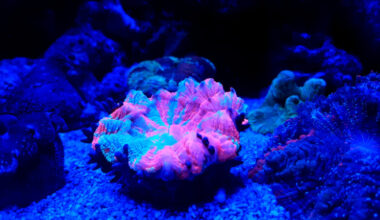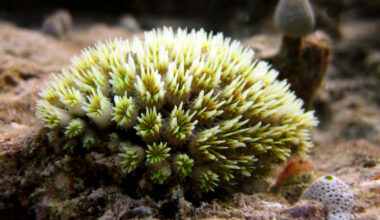If you’re fascinated by the colorful and mesmerizing beauty of Acan corals, you’ve come to the right place. Acan corals are sought after by reef enthusiasts for their vibrant hues and intricate patterns.
In this guide, we’ll explore the fundamental aspects of lighting, water quality, and placement, ensuring that you have a solid foundation for successfully caring for your Acan coral. Let’s embark on this Acan coral care journey!
Table of Contents
Species Summary
The Acan Coral’s scientific name is Acanthastrea spp, and it is part of the Lobophyllidae family just as the Lobo Coral.
Its common names are:
- Acans
- Acan lords
- Micromussa
- Micros
- Micro lords
The Acan Corals were originally found in the Indo-Pacific, specifically throughout Australia, Japan, Tonga, Fiji, the Solomon Islands, and the Red Sea. They can be found in large colonies on shallow reefs as much as 98 feet deep.
Appearance
It is not uncommon to confuse the Acan Coral with species of the Mussidae and Merulinidae families. However, Acan Corals resemble suction cups with their round, puffy edges and deep, smooth interior. Additionally, they can be found in a range of beautiful patterns and colors, including purple, blue, green, red, yellow, and orange.

Three Popular Types of Acan Corals
When deciding which Acan coral to add to your aquarium, the three most popular are as follows:
Acanthastrea echinata. These corals feature a sleek appearance with colors usually found in shades of green, orange, and red. Compared to the Micromussa lordhowensis and Acanthastrea bowerbanki, they have medium-sized polyps and flatter colonies.
Acanthastrea bowerbanki. If you are looking to add an odd-shaped coral to your tank, you may enjoy the Acanthastrea bowerbanki. While their polyps are bigger and puffier than the other species, their bodies are also flat and bumpy to create a unique shape.
Micromussa lordhowensis. This is a good choice if you want the smallest of the three species. They feature a variety of gorgeous patterns and colors, complete with detailed lines and gradients.
Author Note: The Micromussa lordhowensis was once known as the Acanthastrea lordhowensis. After being reclassified in 2016, it is no longer considered a type of Acan coral, but many aquarists still refer to this coral as an Acan “lord” variety.
Lifespan
Assuming the proper care is provided, the Acan Coral could live for hundreds of years.
Average Size
The size of your coral will depend on the lighting conditions, and on average Acan Corals have .5 to 1.5-inch polyps and a coral structure of 10 millimeters in diameter.
Acan Coral Care
When it comes to caring for Acan Corals, they have an easy-to-moderate difficulty level. You need to follow specific guidelines for factors such as tank size, tank setup, and water parameters.
Tank Size
You may be able to place your Acan coral in a 5-gallon tank assuming you meet their lighting and water flow requirements. Otherwise, it is best to place your corals in a tank size of 10 gallons or more. This way, they have ample room to grow and thrive in their aquarium.
Water Parameters
It is important to provide stable water conditions to ensure your corals receive enough nutrients, which encourages growth. Acan Coral thrives more in an unbothered environment, so you want to get the water parameters as close to the target range as possible.
Water temperature: 72–82 degrees Fahrenheit (22.2-27.8 degrees Celsius)
pH levels: 8.0-8.4
Water hardness: 8-12 dKH
Specific gravity: 1.025
Calcium: 350-450ppm
Magnesium: 1200-1350ppm
Nitrates: 1-10ppm
Phosphates: 0.01-0.05ppm
Tank Setup
Properly setting up your tank will be the key to succeed with your Acan coral. They are not too demanding but the environment does play a role in how big and colorful they grow.
Placement
Acan Corals prefer to grow on a rock and do well on or near sandbeds, so you want to provide both elements in their environment. Just be careful not to place your Acan coral on a main rockwork, otherwise it will grow as much as the conditions allow it causing trouble to other corals.
It is best to leave at least 6 inches between your Acan Corals and other corals. Acan Corals are semi-aggressive and may bother the other corals in your tank. Remember, they have sweeper tentacles and need plenty of space to grow.
Lighting
It is vital to keep your Acan Coral’s natural habitat in mind when adding light to their aquarium. These corals stay away from intense sunlight, so using too much light to highlight their colors may cause stress. The result is a coral that no longer extends its polyps, which leads to starvation.
Low-to-moderate actinic lighting with a PAR of 25 to 50 is a safe choice because it allows for photosynthesis without unnecessary stress.
Author Note: While different types of lighting, such as T5HO and LED lights can create different appearances, you should always monitor the response of your Acan corals to determine what works best for them.
Filtration
You need to ensure your tank has a low-moderate water flow. If the water flow is too intense, you risk retracted polyps, discoloration, or other damage to your Acan coral.
Moreover, since Acan Corals are filter feeders the proper flow is essential for pushing food towards them and it also prevents debris from accumulating between your coral colonies.
Acclimation
When acclimating your Acan Corals, you want to start by dipping them in a mixture of their transport water and your aquarium water for 30 to 45 minutes. This removes bacteria, parasites, and protozoans that may cause damage to your other corals. It keeps your Acan Corals healthy as well.
You also need to turn down the light and water flow for several days. Spend the next week gradually raising the light and water flow to a normal level. This way, you can avoid placing them in lighting and flow that are too intense.
Common Possible Diseases & Prevention
While Acan Corals are hardy and do not easily fall victim to common ailments, poor conditions can still cause issues.
If you notice a retracted polyp, exposed skeleton, or bleaching, your coral may be stressed or dying. A retracted polyp is especially bad because it means your coral is not eating.
Now, you need to identify the source of trouble by inspecting the tank’s setup and conditions. For example, intense light and water flow, lack of nutrients, and fighting with other corals are all factors that negatively impact your Acan Coral.
Luckily, you can correct most issues by following and adjusting to the recommended water parameters.
Author Note: If you can’t or don’t want to adjust any parameters, you can also relocate your coral to a spot with low-moderate light and flow but always isolate it from the mainrock to prevent conflict with other corals.
Feeding
These photosynthetic corals feed on the zooxanthellae that live in their tissues. Acan Corals also feed off the nutrients in their water column but this is not enough. Target feeding your corals two to three times a week will ensure they are fully nourished. While these corals usually feed at night, they can adjust to daytime feedings.
You can provide your Acan corals a diet consisting of Artemia, copepods, chopped seafood and even some frozen foods like pellets, and flakes. It is exciting to watch your corals extend their polyps to catch their food.
Author Note: Target feeding prevents waste from accumulating in your tank and causing poor conditions for your entire aquarium.
Acan Coral Tank Mates & Predators
You can place your Acan Coral in a tank with most species, as long as you remember to isolate their rock from other corals to prevent conflict.
Good tankmates include:
- Cardinals
- Damselsfish
- Firefish
- Select Wrasses like the Red Coris Wrasse as long as they don’t inadvertently damage the coral when moving nearby rocks and structures
- Tangs (try the Kole Tang)
Shrimps and other invertebrates should only be added to your aquarium if they are reef-safe. The Peppermint and Sexy shrimps are two reef-safe options.
It is essential to avoid placing species that are not reef-safe in your aquarium, especially if they pose a threat to your coral or other species.
Blennies and Gobies are reef-safe fish that should be avoided because their attempt to perch on your coral may cause it to become stressed and retract. For example, the Diamond Goby can disrupt live corals by its constant sifting and digging, and the Bicolor Blenny might turn its appetite toward coral if it’s not being properly fed.
Fragging
You should never frag Acan Corals before they have fully acclimated to their new surroundings.
It is also vital to ensure you have the right tools and knowledge because these corals are harder to frag than other species. Their skeleton is connected throughout the colony, so you need to use an electric saw to frag these corals. If you are careful, you can frag it with a bone cutter.
Author Note: When fragging your coral, you need to make a simple cut around the polyp. You never want to cut through the polyp because this action could kill your coral.
After you make a clean cut, dip the fragment in iodine or a coral solution to prevent infection and heal potential injuries. Next, glue the fragment to a piece of rock and give it time to heal.
Once your fragment is healed, place the piece in its new location in your aquarium. Learning to frag your Acan Coral is useful for reproduction and dealing with diseases. If you are interested in learning more about fragging, check our comprehensive Coral Fragging Guide.
Wrapping Up
Acan corals can be a captivating addition to your marine aquarium, enriching your underwater world with their vivid colors and intricate designs. By following the care tips outlined in this guide, you can ensure the well-being and longevity of your Acan coral.
Remember to stay vigilant for any signs of stress or changes in appearance, and take prompt action if needed. If you are in need for more information feel free to check our other Coral Care Guides.
By the way, don’t forget to tag us on Facebook when sharing some cool photos of your Acan Coral. Best of luck and if you have questions don’t hesitate to reach out to us (if we don’t have the answer we’ll find it for you).

